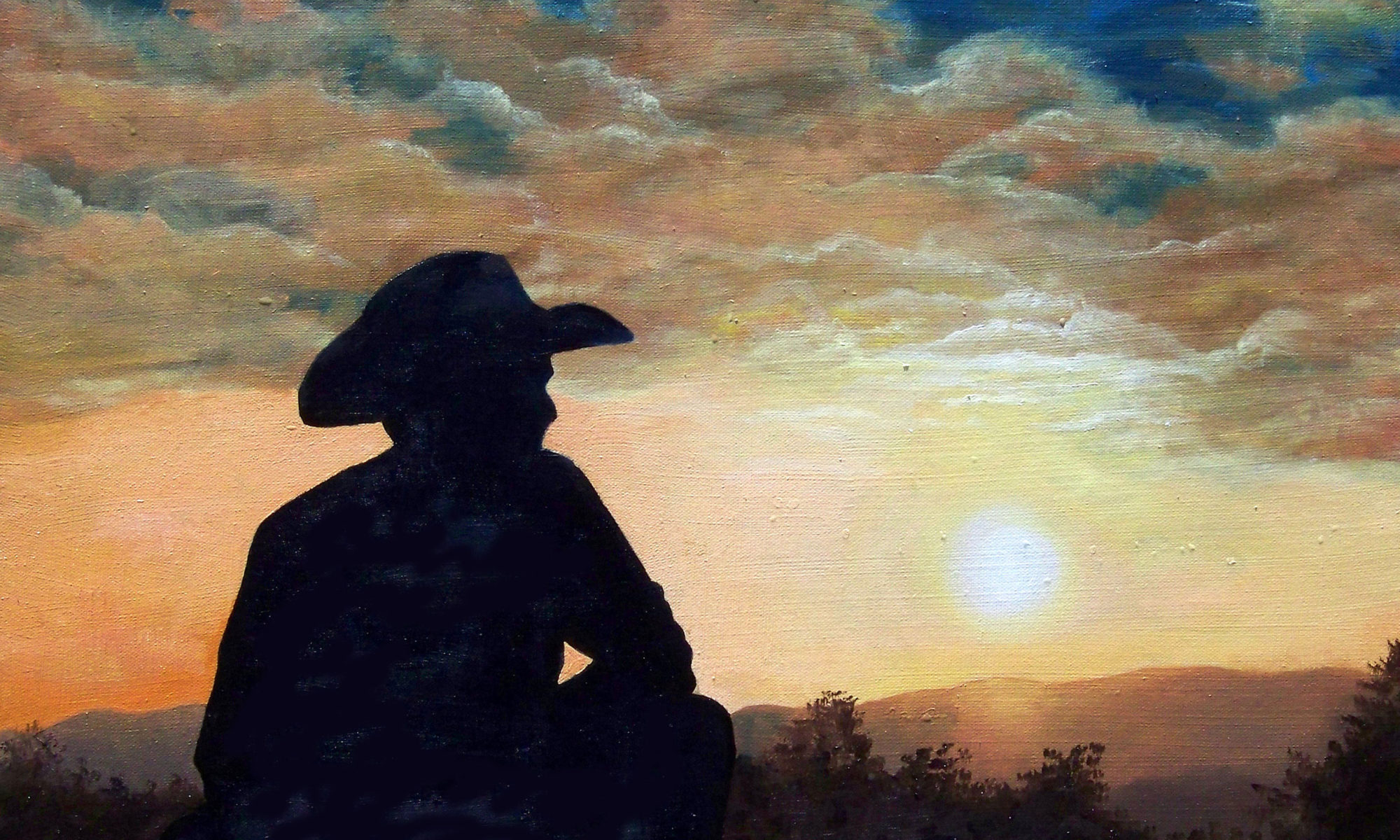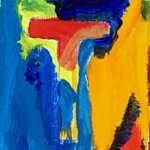
T-SQUARE | TYPOGRAPHY
Quick links to more art terms and definitions are located at the end of the list.
T-square
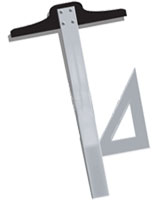
A T-square is a technical drawing instrument used by draftsmen primarily as a guide for drawing horizontal lines on a drafting table. It resembles the letter “T,” with a long shaft called the “blade” and a short shaft called the “stock” or “head”. It’s a valuable tool for precise and straight-line drawing in various fields, including technical drafting, architecture, and graphic design.
Tactile Texture
Refers to the actual sensation that one experiences upon touching a surface, which can include roughness, smoothness, softness, hardness, silkiness, sliminess, stickiness, among others. Three-dimensional art forms, like sculptures and architectural features, possess tactile qualities because they can be physically touched and experienced.
Tempera
Also called “egg tempera,” is a method of painting using pigments (color) bound in a water-soluble emulsion, such as water and egg yolk (plus sometimes glue or milk), or an oil-in-water emulsion, such as oil and a whole egg. It is traditionally applied to rigid supports like wood panel or fresco, and the paint dries quickly to a hard film. This technique was the primary method of applying paint to panels in Italian art until after 1500, when the invention of oil painting superseded it. Tempera paintings are very long-lasting, and their colors do not deteriorate over time.
Tertiary Colors
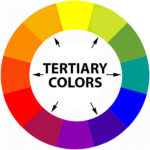
(Also called intermediate colors.)
Red-purple, red-orange, blue-green, blue-violet, yellow-green, and yellow-orange; hues commonly used in painting. There are six tertiary (third in order or level) colors, and they are the result of mixing equal parts of a primary color with a secondary color. The proper way to refer to tertiary colors is by listing the primary color first and then the secondary color.
Tertiary colors are called by their two-word name:
-
- Red + violet (purple) = red-violet (red-purple)
- Red + orange = red-orange
- Blue + green = blue-green
- Blue + violet (purple) = blue-violet (blue-purple)
- Yellow + orange = yellow-orange
- Yellow + green = yellow-green
Tetraptych
(Pronounced tet-rap-tych)
An artwork, usually a painting, divided into four sections or panels, which is commonly used for altarpieces. The panels can be attached together using a hinge or displayed next to each other. The term “tetraptych” comes from the Greek words “tetra” (meaning “four”) and “ptychos” (meaning “fold” or “layer”). Not to be confused with the term “triptych” which consists of only three panels. Also see, “Quadriptych.”
Texture
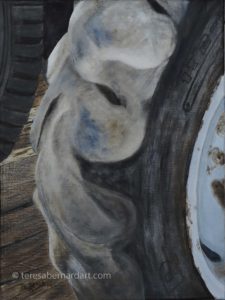
Refers to the way a surface feels or is perceived to feel. It plays a crucial role in both two-dimensional and three-dimensional designs, characterized by its visual and physical properties. Texture is perceptible through touch (tactile) and sight (visual), and it plays an essential role in creating intrigue, contrast, and mood in art. Texture adds depth, complexity, and visual interest, to an image, making it seem more real. When used with other design elements, texture can convey a wide range of messages and evoke various emotions. Also see “tactile texture” and “visual texture.”
Three-dimensional Art
(Also called “3D art.”)
A form of visual art that occupies physical space and can be viewed and interacted with from all sides, incorporating the dimensions of height, width, and depth. Three-dimensional objects include sculpture, architecture, installation art and many decorative art forms.
Three-dimensional (3D) Space
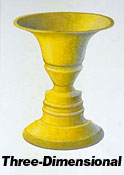
A sensation of space that seems to have thickness, width, height, and depth. This perception is created by visual signals that create the illusion of three-dimensional shapes and areas. These 3D signals are common in nature but often go unnoticed. However, when skilled artists use these cues, they can create the illusion of three-dimensionality on a flat canvas surface.
The techniques used to create the illusion of three-dimensional space are:
-
- Overlapping objects
- Changing the size and placement of related objects
- Linear perspective
- Relative hue and value
- Atmospheric perspective
Three-point Perspective
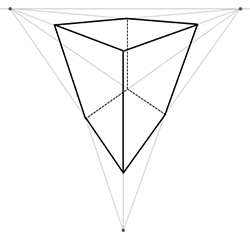
A drawing or painting technique that is a little trickier than one- and two-point perspectives because this type involves three vanishing points. It includes two vanishing points somewhere on the horizon line and also a vanishing point either above or below the horizon that all vertical lines lead to. Three-point perspective is ideal for rendering objects, such as buildings and cityscapes when seen from an aerial or ground view.
Three-quarter View
A face or any other subject halfway between a full and a profile view.
Thumbnail Sketch
Crude, small pencil drawings used to develop the initial concept for a design.
TIFF
Acronym for Tagged Image File Format, a standard graphic image file format usually generated by scanners. Developed by Aldus and Microsoft.
Tint
A hue with white added. Pink is a tint of red.
Titanium
An oxide used as a white pigment of great permanence and covering power. Usually extended with other whites to improve its brushing and drying properties.
Tole
The folk art of decorative painting on tin and wooden utensils, objects, and furniture. Typical metal objects include utensils, coffee pots, and similar household items. Wooden objects include tables, chairs, and chests, including hope chests, toy boxes, and jewelry boxes.
Tone
A term that describes the quality of color. It relates to the perception of a color as warm or cool, bright or subdued, light or dark, and pure or muted. Additionally, it denotes the relative lightness or darkness of a color, its shade, or the degree to which a color appears light or dark.
Transition
The change or passing from one condition, place, thing, or activity to another; the passage linking one subject, section, or part of a composition with another.
Triadic (Triad) Colors
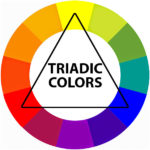
A triadic color scheme consists of three colors that are evenly spaced around the color wheel, creating an equilateral triangle. Thus, every fourth color on the color wheel will make up part of a triad.
Examples of triadic color schemes could be:
-
- Red, Yellow, and Blue (primary colors)
- Orange, Green, and Violet (secondary colors)
- Yellow-Orange, Blue-Green, and Red-Violet (tertiary colors)
- Yellow-Green, Blue-Violet, and Red-Orange (tertiary colors)
Tribal Art
An artform or artifact created by indigenous people that embraces the traditional art of tribal societies in the Americas, Africa, India, the South Pacific, and Australasia. The most common examples of tribal art are masks, paintings, and carved sculptures, many of which are spiritual or religious.
Triptych
(Pronounced trip-tick.)
Artwork that is divided into three painted panels or three relief-carved sections hinged together or displayed side-by-side. The imagery in the three panels may flow together to form a single unified scene, or they may each function as a separate painting yet be related to create a strong sense of visual unity and cohesion. The term “triptych” comes from the Greek word “triptychos”, which means “having three folds” with “tri” (meaning “three”) and “ptychos” (meaning “fold” or “layer”).
Trompe L’oeil
French for “fool the eye.” A two-dimensional representation that is so naturalistic that it looks actual or real (three-dimensional.) This form of painting was first used by the Romans thousands of years ago in frescoes and murals.
Turpentine
A high-quality oil paint thinner and solvent.
Two-dimensional Art
(Also called “2D art.”)
Refers to any form of artistic expression that occurs on a flat surface, such as canvas, paper, walls, or panels. Two-dimensional art is flat, consisting solely of width and height without any depth.
Two-dimensional (2D) Space
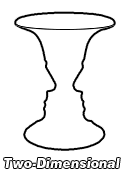
A measurable distance on a flat surface such as a canvas or paper. 2D space shows height and width but lacks any illusion of thickness or depth. It can consist of straight or curved lines or both.
In the example, the two-dimensional image appears flat because all the objects and forms lie on the same plane. It has no feeling of depth.
Two-point Perspective

A drawing technique that involves positioning two vanishing points along the horizon line. This perspective places the object where the viewer can look at it from an angle and see two sides at once. Two-point perspective is often used to render geometric shapes such as boxes, cubes, and buildings with a sense of depth and volume. When looking at the object from the corner, one side recedes towards one vanishing point, while the other recedes toward the opposite vanishing point. Each set of parallel lines has its own vanishing point.
Typography
The study and process of typefaces; how to select, size, arrange, and use them in general. In modern terms, typography includes computer display and output. Historically, typography entailed arranging metal types with raised characters, which would be inked and then pressed onto paper to leave an imprint.
You May Also Like
This art terms terminology is provided as a valuable resource for art enthusiasts. If you like the information here and find it helpful, please consider purchasing a painting. Your support helps to cover the cost of keeping this art lexis online. Simply click or tap the thumbnail link of any Teresa Bernard oil painting to view additional details.
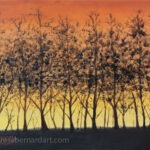
(2022)
12″ w x 9″ h
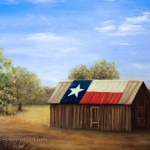
(2015)
20″ w x 16″ h
Art Glossary Quick Links
Contributing to The Art Dictionary
The art terms terminology is a work in progress. New terms and definitions are added on a regular basis. If you know of an art term and definition that isn’t already listed in it, but you believe it should be, send it to us and we’ll consider adding it. We’ll let you know if we do. Thanks!
Thanks for reading this!
